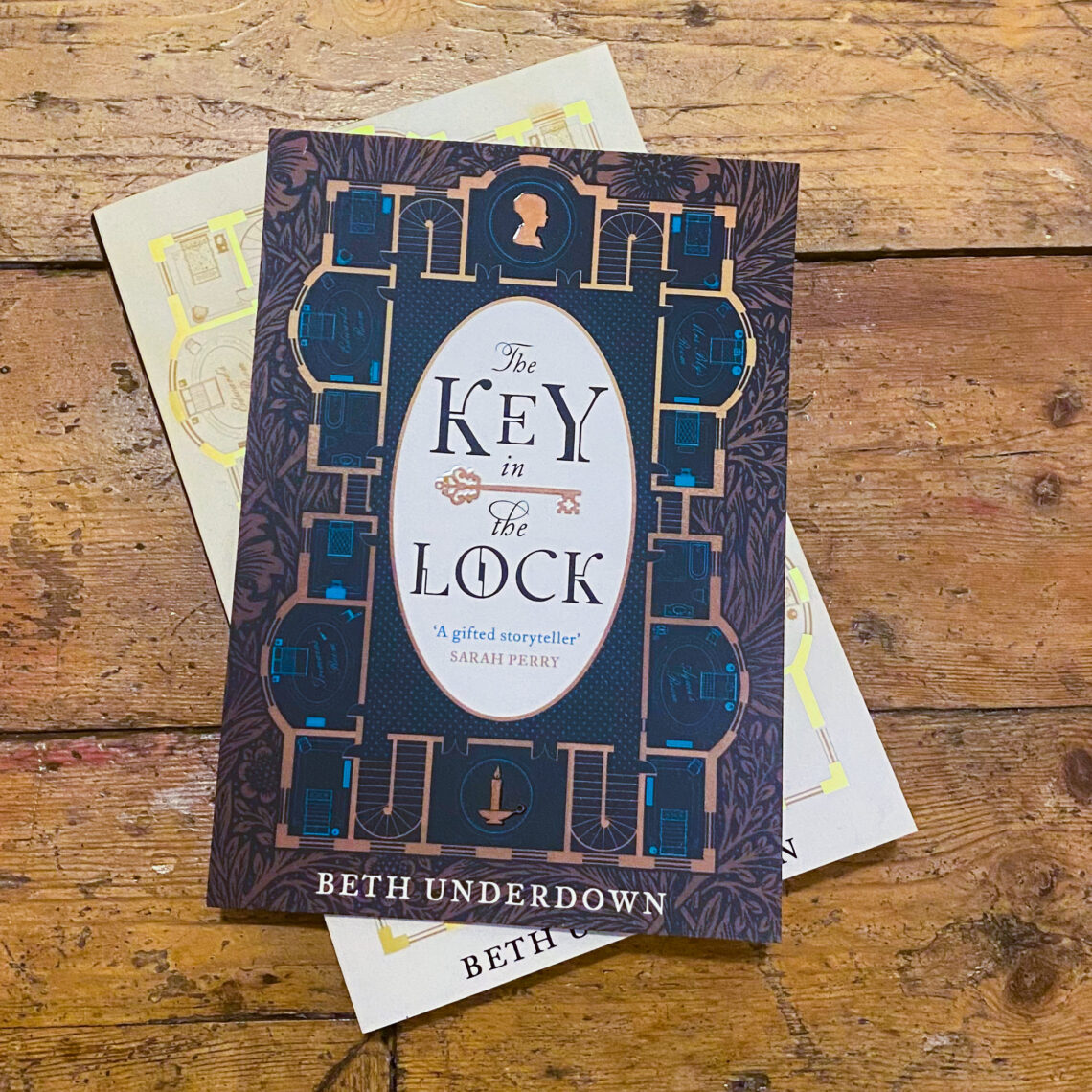Reviews
-
The Atlas Six – Olivie Blake
Damn this book. In an elevator pitch, I’d describe it as sexy and compelling – it’s that kind of book. Once you get sucked into it, you just can’t stop. I’m so glad I’ve got my reading mojo back thanks to these lovely publicists sending me the exact right books to get me out of my slump – The Atlas Six and Blood Scion worked wonders! This is one of the most hyped releases of this spring, and I hate to say it, but the hype is correct…
Massive thanks to Black Crow PR and UK Tor for spoiling me and sending me an ARC. All opinions are entirely my own.
RELEASE DATE: 03/03/2022
STAR RATING: 4.5/5 ✶

SUMMARY: The Alexandrian Society, caretakers of lost knowledge from the greatest civilizations of antiquity, are the foremost secret society of magical academicians in the world. Those who earn a place among the Alexandrians will secure a life of wealth, power, and prestige beyond their wildest dreams, and each decade, only the six most uniquely talented magicians are selected to be considered for initiation.
Enter the latest round of six: Libby Rhodes and Nico de Varona, unwilling halves of an unfathomable whole, who exert uncanny control over every element of physicality. Reina Mori, a naturalist, who can intuit the language of life itself. Parisa Kamali, a telepath who can traverse the depths of the subconscious, navigating worlds inside the human mind. Callum Nova, an empath easily mistaken for a manipulative illusionist, who can influence the intimate workings of a person’s inner self. Finally, there is Tristan Caine, who can see through illusions to a new structure of reality—an ability so rare that neither he nor his peers can fully grasp its implications.
When the candidates are recruited by the mysterious Atlas Blakely, they are told they will have one year to qualify for initiation, during which time they will be permitted preliminary access to the Society’s archives and judged based on their contributions to various subjects of impossibility: time and space, luck and thought, life and death. Five, they are told, will be initiated. One will be eliminated. The six potential initiates will fight to survive the next year of their lives, and if they can prove themselves to be the best among their rivals, most of them will.
Most of them. (from Tor)
OPINIONS: There are many different things I tend to like about books. But selfish people in an academic setting, competing, sleeping with each other and other people and a healthy dose of backstabbing and magic is a formula that never fails to grip me. And The Atlas Six can compete with the best of them in that regard. It is the sort of book you just have to devour once you get stuck in, the kind that makes you stay up far later than you’d like because you simply need to know how it ends. And now I am eagerly waiting for book two…
It is not highbrow or necessarily the most creative story out there. It is made up of a slew of tropes, but I think that’s exactly where this book’s charm lies. It takes many of the elements from books we’ve all read and loved growing up and turns them into pure entertainment. In some ways, The Atlas Six is a The CW show of fantasy books – glossy, full of beautiful people who really are horrible, and compulsively readable, pure escapism. And for me personally, that’s exactly what made it resonate so much. Taking these shiny elements that made it fun, adding a good pinch of escapism and combining that with the magic school and library setting that I click with as a book nerd? You’ve got a winning formula there.
And despite the characters all being objectively terrible and selfish people with moral issues, I loved basically all of them. For me, that speaks to good writing – because them being interesting mattered more than them being actually likeable, and they charmed their way into my heart anyways. I think my favourite was probably Libby, disaster bisexual that she is, with her weird rivalry with Nico, bordering on obsession. But honestly, all I want to do is start rereading the book again. I have a feeling this may become a comfort read…
Add The Atlas Six to your Goodreads here, and pre-order a copy via Bookshop here (affiliate link), though it’s worth checking if Waterstones, Illumicrate or Fairyloot still have any of their announced special editions available…
-
The Novellas of Osten Ard
Over the past year, I had the pleasure of returning to Osten Ard with two novellas that book-end the original Memory, Sorrow, and Thorn series: The Heart of What Was Lost and Brothers of the Wind. Once again I am astounded by the greatness that is Tad Williams. I know, I know, I’m a total fangirl, but I can’t help but argue it’s with good reason! For fans of Tad Williams, getting the opportunity to return to the rich and sprawling world that is Osten Ard with a targetted, short-format purpose that nonetheless delivers his style of prose, world-building, and characterization (twice!) is beyond satisfying to say the least. For me, it’s like wrapping myself in a warm blanket and drinking a cup of tea – pure comfort through the written word. Although these novellas vary significantly in terms of their themes and objectives, they are both quintessentially Tad Williams and fit perfectly into and expand upon the experience of Osten Ard. All opinions are my own.
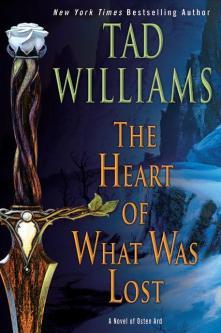
Publication Date: January 3, 2017
Rating: 5/5 ✶
Summary: The Heart of What Was Lost takes place in the half-year after the end of To Green Angel Tower, and tells of the attempt by Isgrimnur and a force largely made up of Rimmersgard soldiers to destroy the remaining Norns as they flee back to their homeland and their mountain. It also answers some questions about what actually happened in the immediate aftermath of the fall of Green Angel Tower.
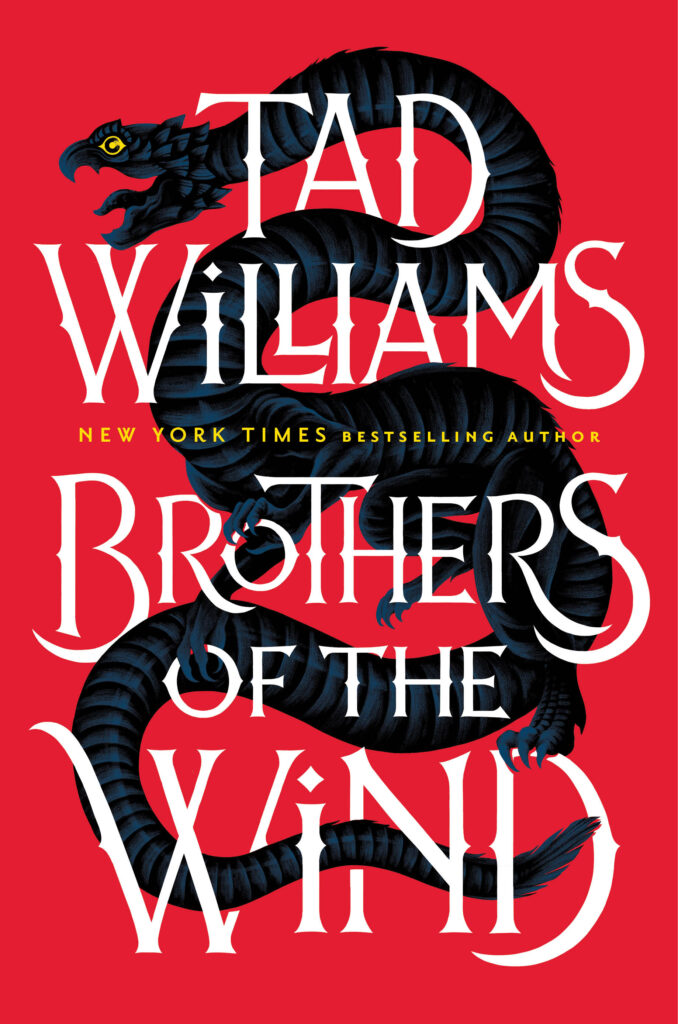
Publication Date: November 2, 2021
Rating: 4/5 ✶
Summary: Set a thousand years before the events of Williams’s The Dragonbone Chair, Brothers of the Wind tells the tale of Ineluki’s tragic boast to destroy the deadly dragon Hidohebhi and what it brings from the POV of Pamon Kes, Hakatri’s faithful servant. Kes is not one of the Sithi but a member of the enslaved Changeling race, and his loyalty has never before been tested. Now he must face the terrible black dragon at his master’s side, then see his own life changed forever in a mere instant by Ineluki’s rash, selfish promise.
The plot of The Heart of What Was Lost focuses on Duke Isgrimmnur’s pursual of the retreating Norns and epic siege of their home Nikkiga (siege fans – this book is for you!) after the human and Sithi victory at Asu’a. The plot forms the basis for not only delivering page-turning action and world-building, but also two main themes: the tendency the de-humanize an enemy in war, in this case the Norns, and a reminder that the atrocities and brutalities of war exist on a personal level and represent its true cost.
Williams’s use of multiple POVs is strategic and perfectly executed to support the book’s themes. First, he presents part of the story through the contrasting viewpoints of Duke Isgrimmnur, who leads the charge on Nikiiga, and Viyeki, a noble-born Norn working to protect his race from being exterminated at the hand of the human invaders. After witnessing the atrocities of the Norns throughout Memory, Sorrow, and Thorn, this fascinating juxtaposition in POVs requires an empathy from the reader that is unexpected and yet very real. The Norns are a noble people in their own right, simply fighting for their existence. Experiencing their way of life within their home “humanized” the Norns and further deepened the world-building of Osten Ard in a way that changes your view on the war.
Williams pulls on your hearstrings in an entirely different manner with a third POV, that of Porto, a mercenary conscribed to help finish the war in the North. The care-abouts of an average soldier and his young comrade-in-arms, e.g. wanting to return home to family, questioning why they are there, hunger and cold, provide a stark contrast to the “noble endeavor” of eliminating the last vestiges of their land’s mortal enemies. Here the reader is reminded of the brutal realities of war, and for me, the reminder was poignant.
Finally, and as always, Williams is adept at weaving the stories of these myriad characters in such a way that the ending is both powerfully unexpected and thoroughly satisfying; all loose ends are tied.
Brothers of the Wind tackles entirely different themes using the single POV of Pamon Kes, Prince Hakatri of the Sithi’s armiger servant of the enslaved Changeling race. The book is split into two main quests, the first of which is to slay the dragon Hidohebhi, and the second to find a cure for the pain and madness plaguing Hakatri who has been burned by Hidohebhi’s magical blood. Aside: It was a delight to visit all my favorite locations in Osten Ard during Hakatri’s quest for a cure – the Wran, Sesuad’ra, Aldheorte, to name a few. It was like a mini-recap of Simon’s journey through Memory, Sorrow, and Thorn, and I thoroughly enjoyed it!
Again, in true Williams fashion, the plot serves the themes, which are twofold and strikingly disparate. First, he explores the slippery slope that is unchecked hubris and anger. Readers are finally presented with the backstory of Prince Ineluki’s seduction by the Norn queen. She manipulates Ineluki’s anger with himself and his love for his brother into hatred for the humans, thereby providing him an outlet for his tumultuous emotions and ultimately gaining his allegiance. At the same time, Williams tells this entire story through the POV of Hakatri’s devoted servant. The reader is not only given a deeper understanding of the Changeling race, but also the sacrifces Pamon has made with respect to his identity – both through his own choice and unintentionally through racism and social constructs – because of his blind devotion to his master Hakatri. The noble Sithi are not without fault, and once again the world-building of Osten Ard is deepened through the exploration of this unsettling relationship between the Sithi, Norn, and Changeling races.
There is a heart-warming end for Pamon Kes; he is released of his servitude to live his own life and learn the history of his people. But, surprisingly, the reader does not learn the ultimate fate of Hakatri. Does he ever find his relief across the sea? Who was the mysterious woman in his visions, and what was the choice she foretold he might make? How will this affect Osten Ard? Williams has left the door open for these questions to be answered in the final two installments of The Last King of Osten Ard, but the conclusion of the story did not suffer because of it.
It was a pleasure to return to the world of Osten Ard and several of its characters in these two novellas. The stage is set for the follow-on series, The Last King of Osten Ard. Although you don’t have to read Memory, Sorrow, and Thorn to enjoy either of these short books and get a feel for Williams’s manner of writing, the context is key to experiencing the full impact of their objectives. Highest of recommendations!
-
Blood Scion – Deborah Falaye
It’s been a while since I’ve just sat down and raced through a book in a single sitting, but I did that with Blood Scion by Deborah Falaye. Originally drawn in by the gorgeous cover before I even knew what the book was about, I soon fell in love with the world Falaye built for her debut and I can’t wait to read book two.
Many thanks to Harper360YA for sending me an ARC for review, and as usual, all opinions are my own.
RELEASE DATE: 08/03/2022
STAR RATING: 4.5/5 ✶
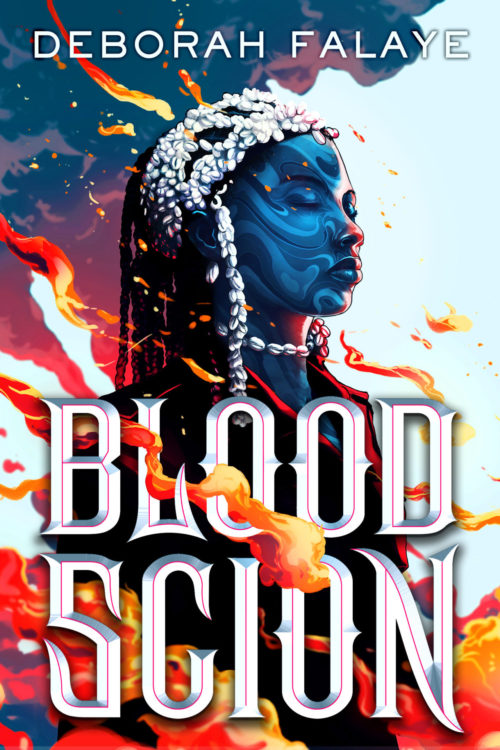
SUMMARY: Fifteen-year-old Sloane can incinerate an enemy at will—she is a Scion, a descendant of the ancient Orisha gods.
Under the Lucis’ brutal rule, her identity means her death if her powers are discovered. But when she is forcibly conscripted into the Lucis army on her fifteenth birthday, Sloane sees a new opportunity: to overcome the bloody challenges of Lucis training, and destroy them from within. (from Harper Collins)
OPINIONS: I loved Blood Scion. This is one of the most addictive books I’ve read in ages, which is saying something – I think it’s pulled me out of a rut I didn’t even realise I was in. I need book two immediately and I don’t want to wait for it to be released (yes I am aware that this one isn’t even out yet…). The story is full of magic, darkness, betrayal and other wonderful ingredients – and minimal romance. It really felt like the book was about Sloane and her journey, about her discovering herself and who she is, rather than trying to pair her up or take away her personal development by focusing on a dynamic. And this really is what YA should be about. A main character who is well-developed, growing into their own, with their character arc at the heart of the story. Blood Scion reaffirmed my love for YA, and I am so happy I got to read it.
Now, Blood Scion is a dark book in many ways. It’s essentially about child soldiers, and the main character has to murder a loved one a few pages into the story. While it is still YA, it is also borderline Grimdark, and will certainly appeal to those audiences as well. The publisher comps it to The Children of Blood and Bone and An Ember in the Ashes, but I think an almost more apt comp in terms of darkness and setting would be Tochi Onyebuchi’s War Girls. However, that does not mean that Blood Scion doesn’t have it’s tender moments. As a whole, it feels balanced and to an extent even hopeful in its spirit.
One of my favourite aspects of the book is how it subtly incorporated aspects of Nigerian Yoruba mythology into its story. I am an absolute sucker for anything rooted in myth, so that just made me love it even more – and this was both subtle and worked really well. Really, Blood Scion is a book where there isn’t a lot to criticise, just a great read.
I highly recommend this one. Add it to your Goodreads here, or pre-order a copy via Bookshop here (affiliate link).
-
Mort the Meek and the Monstrous Quest – Rachel Delahaye
Mort the Meek is back! I loved the first Mort book when I read it last year – Mort the Meek and the Raven’s Revenge – see my review here, and so I jumped on the chance to request book two when it came out. This is more of the same macabre kids humour combined with wonderful illustrations and quirky narration, so just a gem all around.
Many thanks to Little Tiger for sending me a review copy, all opinions are my own.
RELEASE DATE: 06/01/2022
STAR RATING: 4/5 ✶
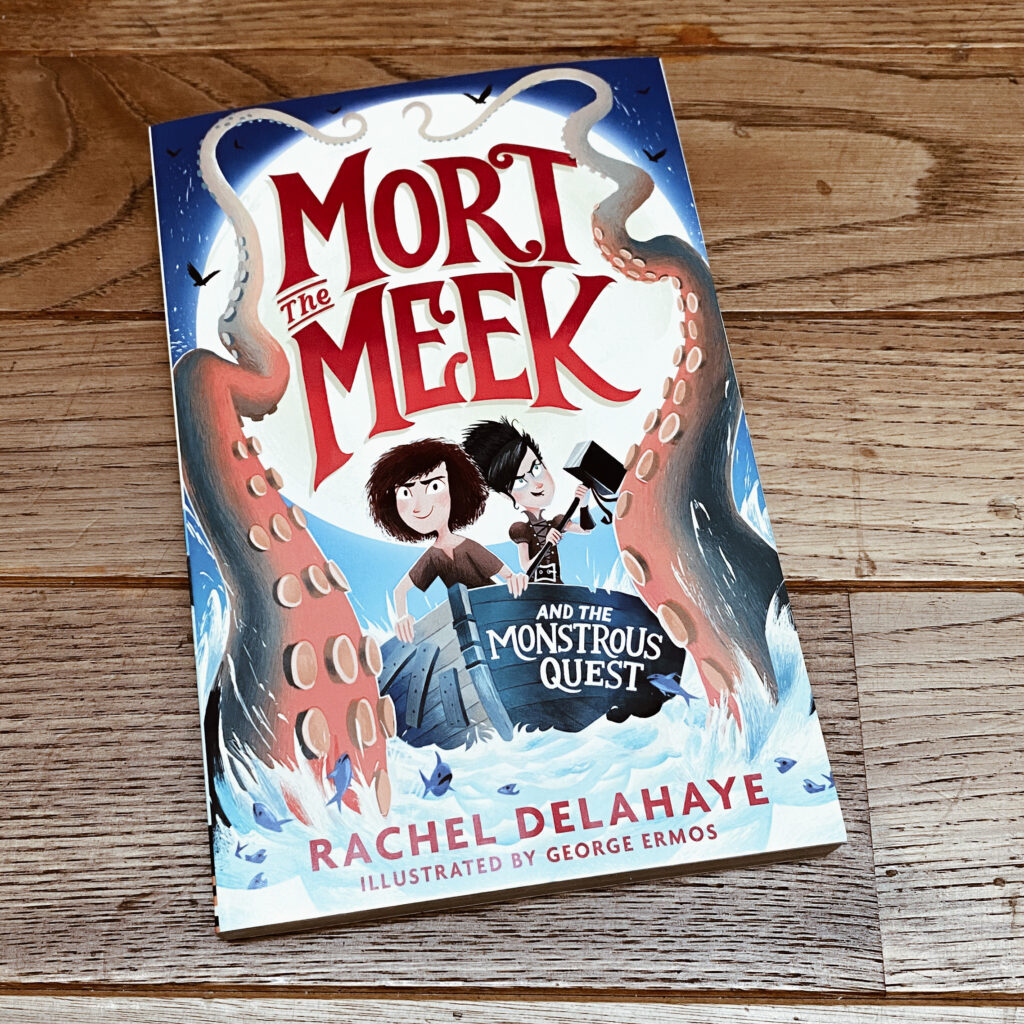
SUMMARY: Around the unfriendly, rocky island of Brutalia, the waves are awash with brave sea-farers, on a treasure hunt for their demanding queen. Among them is Mort, but rather than hunt for treasure, he’s more interested in looking for his family who are lost at sea. Unfortunately, his shipmate Punky has her eyes firmly on the prize.
But when the pair find the tentacle of a mythical sea creature, their adventure takes a dramatic turn. Is this the prize-winning treasure Punky and the queen seek? Or could it be a monstrous twist in Mort’s rescue mission? (from Little Tiger)
OPINIONS: I just love these books. They remind me a bit of A Series of Unfortunate Events aimed at a slightly younger audience – and less realistic. This is again narrated by animals explaining words and sarcastically talking about what is going on – sea creatures this time. The focus on lexicon and new vocabulary is one of my favourite aspects, and something I know I would have absolutely adored as a child as well. Set on the island of Brutalia, this second installment takes place quite a bit of time after the first, with enough time having past for Mort’s father and siblings to have gone lost at sea. Their terrible queen has decided that she is now going to be a god queen – and thus asks her citizens to go out and quest to be named half-gods.
Mort joins this expedition – not because he wants to be a half-god, but because he wants to find his missing family. On the way, he is paired up with the infuriating Punky, who has a soft core beneath her hard exterior, loses his pacifist ways and accidentally becomes a fish god. In the end, he has to find back to his pacifist roots to find a solution to Brutalia’s problems after receiving help from unexpected allies. Again, the story focuses on how ultimately issues can be solved through thinking and talking rather than violence, which I think is a wonderful message, and one that is very important to drill into the audience’s heads at that age.
I think these books are probably best aimed at young readers aged seven to nine, though my adult self still enjoyed it a lot. Join Mort on his adventures by adding Mort the Meek and the Monstrous Quest to your Goodreads here, and ordering a copy via Bookshop here (affiliate link).
-
The Amber Crown – Jacey Bedford
A standalone epic fantasy that hits familiar beats in interesting ways with a strong cast that earns their bonds and uses the familiar as a bedrock to add surprises along with a keen eye for detail.
Many thanks to Stephanie at DAW for sending me an eARC, all opinions are my own.
RELEASE DATE: 11/01/2022
STAR RATING: 3.5/5 ✶
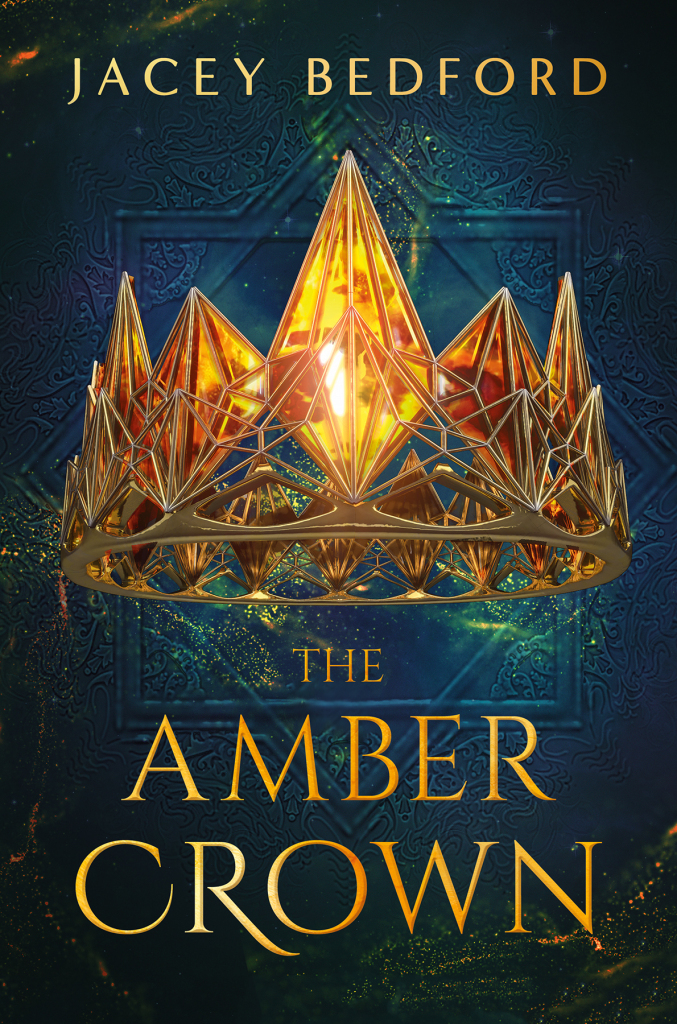
SUMMARY: The king is dead, his queen is missing. On the amber coast, the usurper king is driving Zavonia to the brink of war. A dangerous magical power is rising up in Biela Miasto, and the only people who can set things right are a failed bodyguard, a Landstrider witch, and the assassin who set off the whole sorry chain of events.
Valdas, Captain of the High Guard, has not only failed in his duty to protect the king, but he’s been accused of the murder, and he’s on the run. He’s sworn to seek justice, but his king sets him another task from beyond the grave. Valdas doesn’t believe in magic, which is unfortunate as it turns out.
Mirza is the healer-witch of a Landstrider band, valued and feared in equal measure for her witchmark, her scolding tongue, and her ability to walk the spirit world. When she’s given a task by Valdas’ dead king, she believes that the journey she must take is one she can never return from.
Lind is the clever assassin. Yes, someone paid him to kill the king, but who is to blame, the weapon or the power behind it? Lind must face his traumatic past if he’s to have a future.Can these three discover the real villain, find the queen, and set the rightful king on the throne before the country is overcome?
OPINIONS: The Amber Crown is a stand-alone with many of the trappings of epic fantasy squeezed into a single story. Set in a Central-European-inspired country, the story draws more from the late Renaissance with traders, merchants, a semi-prosperous middle class, and guns, rather than the typical medieval. The plot itself is very traditional with a group going on a quest, an uncertain power vacuum, and an unseen evil lurking underneath it all. While this sounds the same old, same old, the familiarity allows the differences to become more apparent and it’s the characters that make it, as well as a solid execution. It’s important to note that whilst the world is not grimdark, there are mentions of sexual assault, a scene of attempted rape, and a flashback to the rape of an adolescent. They’re addressed within the story and aren’t just used as set dressing or to set a tone but readers may want to approach with caution.
Valdas is the most straightforward of the three POV characters. He’s loyal, honest, and willing to accept responsibility. However, he’s also a bit crude and loves women although he knows how to accept boundaries. He’s also the one that I feel changes the least through the story. He already knows himself and mostly what kind of person he is so doesn’t go through the path of growth the other two do, although through his experiences he becomes more open-minded and tolerant of others.
While I liked Mirza with her pragmatism, sharpness but also a strong sense of fairness and compassion she does get the raw end of the deal a lot of the time. At the beginning of the story, she has to fight for the respect of her band, having recently been an apprentice who had outpaced her master but was forced to hide it. As she continues to show her abilities to her band and later convinces Valdas of the existence of magic, her willingness to do what’s right overall despite the hardship it might cause her becomes a defining trait.
Lind is the most complex of the three and the most morally ambivalent. Through the story, we see his cleverness and his quickness but also Lind’s experiences as an assassin for hire are grounded more in detail than usual with descriptions of disguises and methodicalness of planning required rather than violence and a quick getaway. All three have very distinct voices and the bonds between each of the characters are slowly developed and earned rather than forged in an instant through peril.
In terms of writing the short chapters maintain the pace of the book and help to keep momentum between the characters, particularly in the earlier parts. Each POV feels very different so it’s enjoyable to switch between them. There are also interesting bits of worldbuilding such as Lind’s mention of changing fashion adds a sense of vibrancy and of living culture rather than things being set in stone. The poor judgment of the new king is also mentioned through the references to new taxes in subtle asides. The Amber Crown would be a good fit for people who love epic fantasy but aren’t ready to commit to a long-running series.
-
A Tale of Two Faerie Tales
So often we see recommendations based on certain keywords or subgenre classifications, and it’s easy to fall into the trap of reducing recommendations to this basic approach. Using such an approach, two books might appear to be excellent recommendations for a single request; however, the art of the successful recommendation is far more nuanced.
We’ve all seen something like this before: “Recommended to those who like the Fae, Romance, and Regency- or Victorian-era language and settings.” In fact, this exact description could be used for two books I’ve recently read and are currently quite popular in Speculative Fiction circles, namely Half a Soul by Olivia Atwater and The Lord of Stariel by A.J. Lancaster. Based on that description alone someone might recommend both of these books to a single request, and they will have varying degrees of success, because these two books are in fact quite different. So, I present to you A Tale of Two Faerie Tales, short reviews of two books that – on paper – should appeal to the same reader and fulfill similar recommendation requests, but differ significantly in their tone, themes, and purpose.
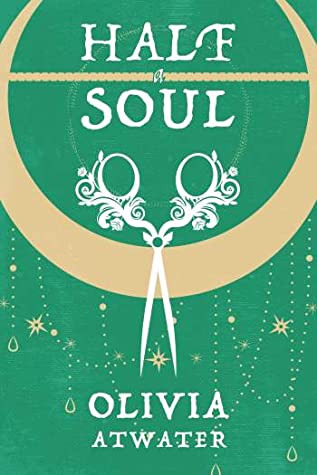
Publication Date: March 29, 2020
Rating: 3/5 ✶
Kat’s Summary: As a child, half of Dora’s soul was stolen by an evil lord of Faerie. Now, a young woman who has debuted in Regency-era England, Dora finds herself searching for her place in society, never really fitting in, because she’s missing some part of herself. When her family travels to London to find a husband for her cousin, she meets the ill-mannered Lord Sorcier, who has vowed to help her try and mend her soul purely because it’s a challenging problem to solve. Their plans are derailed by a magical plague putting children into an unwakable sleep as well as the dealing with the travesties of London workhouses. Dora and Elias must work together to discover the source of the plague and save the sick children before it’s too late. And as they do, will they be able to deny the feelings that are unexpectedly developing between them?
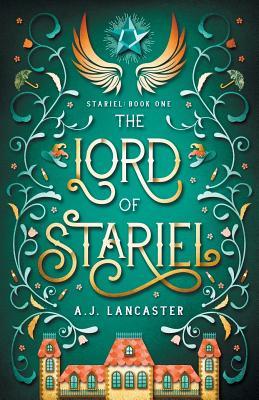
Publication Date: November 1, 2018
Rating: 3/5 ✶
Kat’s Summary: Hetta is the unconventional daughter of Lord Stariel working as an illusionist in a theater. She must return to her estranged family’s estate after learning her father has passed away to take part in the Choosing ceremony in which the sentient land of Stariel will pick its next Lord. After being unexpectedly chosen, she must work within her small band of friends – her brother Marius, her cousin Jack, and her mysterious friend (and newly discovered love interest) Wyn – to understand the land’s magic, the arrival of unexpected Fae guests, and uncover the motivation behind a plot to seat her as the Lord regardless of the Choosing Stone’s intent. Can they uncover who is behind all the machinations in Stariel and restore order before any more dangerous Fae incursions put their land and family at risk?
I’ll start with how these books are similar, namely their prose and language. Half a Soul is set in Regency-era England; the existence of magic and Faerie is simply overlaid atop this historic setting. The Lord of Stariel, on the other hand, is set in a secondary world reminiscent of late-Victorian England. Despite these inconsequential setting differences, both books have beautiful, soothing prose, and more importantly the language used fits their quasi-historical settings. It evokes the atmosphere you’d expect from a fantasy-of-manners and helps amplify the desired, historic English atmosphere.
To me, the prose and language is the strongest similarity between the two books; in fact, the remaining similarities fall under the vein of : They both…, but…
First, there is a noticeable difference in tone. Half a Soul is a very much a classic fairytale, complete with the requisite character tropes – the evil stepmother (Auntie Frances), prince charming (Lord Sorcier), etc. – and carries a tone that matches what you’d expect from a fairytale. Words I’d use to describe the tone are sweet, whimsical, emotional. Atwater creates this quality through both the characters and the setting. Dora is young and innocent, and Lord Stariel hardened and melodramatic. They are established as emotional opposites, Dora having lost the capacity to truly feel, and Elias deeply affected by his conscience and feelings. The author leans into this contrast, and the emotional drama that ensues contributes to the fairytale atmosphere. The journey into Faerie amplifies this further by presenting an absurd and exaggerated version of Regency-era society and mores in a manner reminiscent of Alice in Wonderland.
In contrast, The Lord of Stariel presents the reader with a less frantically emotional approach that is far more akin to “slice-of-life” story-telling. Despite being a “faerie tale,” the tone is measured and subdued, resulting from both mature characters and the author’s presentation. Hetta is an established adult with her own job, home, and independence. She is experienced in both life and relationships. She is an unconventional woman in conventional society, and yet still adheres to the expectations of her family and propriety. Her manner, coupled with a plot that is largely interspersed with the mundane – meals, gatherings, outings, and meetings about the estate – delivers a feel that is more commensurate with a fantasy-of-manners than a traditional fairytale. And although the Fae are present, most notably in Wyn, the events seem more realistic as they are not described in an over-the-top manner, the revelations and interactions handled as if they were “normal” life events.
Second, both books contain romantic elements, but to unmistakably different degrees. Half a Soul is most definitely a Fantasy Romance and it is clear from the start that Dora and Elias are developing an unexpected and deep connection to one another. Their relationship evolves slowly over the course of the book, and the appropriate amount of time is spent developing both of the characters as well as their relationship such that the reader is invested in their success as a couple and the book can deliver a satisfying HEA. Dora and Elias have meaningful character arcs that are tied to their emotional states and their world views. Their attraction to one another is borne out of those arcs, based not in lust but shared experience and respect, creating a truly powerful romantic connection. (The scene where Elias attends the ball to dance with Dora under magically sparkling lights was perfectly romantic!)
The romance in The Lord of Stariel falls squarely into the category of romantic subplot at best. It’s likely (based on chats with those that have read the entire series) that this book provides the set up necessary for a more fleshed-out romantic subplot later on. But if someone is looking for a strong romantic subplot, I probably wouldn’t recommend this book. It’s a bit thin for my taste, even if I did find their eventual coming-together a highlight of the ending. One of the reasons the romantic subplot was so thin, was that unlike Half a Soul, Hetta and Wyn’s character arcs were not fully fleshed out in service of the romance, much of their attraction portrayed as lust. It was disappointing that Hetta did not explicitly choose to stay in Stariel. Giving this decision more emotional treatment and tying it to Wyn, even in the slightest, would have given Hetta more agency and made the romantic subplot far more compelling.
And finally, there is theming, or objective. Half a Soul, in true fairytale fashion, is not shy in delivering its message: virtue is not found in material wealth or in being a part of the aristocracy. By the end of the book, after tours through the horrific conditions of the workhouses and the journey to Faerie that mirrors Regency-era mores in an exaggerated manner, the reader can’t help but “get the message.” I would go so far as to say that the messaging could have been tempered a bit and still delivered its point! But that’s the purpose of many traditional fairytales, isn’t it? And so it worked within the context of the book’s tone and objective.
The Lord of Stariel is subtle in its purpose and messaging. Here, the reader is presented with themes that are less heavy than the single, overarching moral that drives its counterpart. In fact, the book is light on themes, the strongest of which centers around returning to your roots, strengthened by the use of the Stariel family’s connection to the sentient land as a metaphor, and devotion to family. The purpose of this book is not to deliver a message, but to present the reader with a world and cast of characters that they will ostensibly follow throughout the series as it delivers adventures of the reunited family with its new world understanding.
I would happily recommend both of these Faerie Tales. I found them equally delightful, but in markedly different ways. And while they appear to fit within the same proverbial box, for the reasons I’ve outlined above, you’ll likely not see me recommending both of these books to the same request. Half a Soul and The Lord of Stariel scratch decidedly different itches, and attention to what a reader is looking for will pay dividends against the success of recommending one or both of these books. Happy reading.
-
Elektra – Jennifer Saint
One of the most successful titles in the recent boom of mythological retellings is Jennifer Saint’s Ariadne. Blessed with both a hardback and a paperback special edition, and nominated for the Waterstones Book of the Year, I really enjoyed it when I read it last year (see my review here). So to say I was excited for Elektra is an understatement. It looks at one of the most fascinating mother/daughter relationships in Greek myth, that of Clytemnestra, Helen’s sister, and her daughter Elektra – and is another enthralling tale.
Many thanks to Wildfire and NetGalley for the eARC, all opinions are my own.
RELEASE DATE: 28/04/2022
STAR RATING: 4/5 ✶
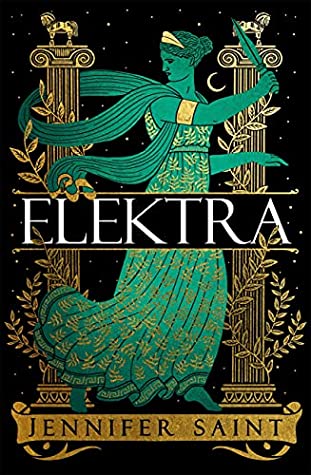
SUMMARY: The House of Atreus is cursed. A bloodline tainted by a generational cycle of violence and vengeance. This is the story of three women, their fates inextricably tied to this curse, and the fickle nature of men and gods.
Clytemnestra
The sister of Helen, wife of Agamemnon – her hopes of averting the curse are dashed when her sister is taken to Troy by the feckless Paris. Her husband raises a great army against them and determines to win, whatever the cost.
Cassandra
Princess of Troy, and cursed by Apollo to see the future but never to be believed when she speaks of it. She is powerless in her knowledge that the city will fall.
Elektra
The youngest daughter of Clytemnestra and Agamemnon, Elektra is horrified by the bloodletting of her kin. But can she escape the curse, or is her own destiny also bound by violence? (from Wildfire)OPINIONS: Elektra is once again an enthralling story of three women often overlooked in mythology. It is quite a bit darker than Ariadne was – how could it not be, centred around this many murders as these interwoven stories are. I enjoyed this as a solid read, although I felt that the book tried to combine what should have been two separate stories into one, not giving either enough scope to delve deep enough. I wish that the book had entirely focused on Clytemnestra and Elektra, as I felt that the inclusion of Cassandra’s storyline meant that the nuances of the mother/daughter relationship, and especially the way it deteriorates and madness potentially creeps in after the sacrifice of Iphigenia didn’t have enough space to be explored in a manner that felt completely satisfactory. It felt like having the third perspective took up too much of the story but didn’t add quite enough in value.
But that doesn’t mean that I didn’t enjoy reading the book – I did very much. Saint’s writing is strong and evocative, and the story compelling. It conjures emotions throughout, as I don’t think there was any part of the book that left me cold (though, much of it was rage at our darling Agamemnon…), and that is truly a credit to the author. I am an absolute fiend for mythological retellings, and so the complaining I am doing here is really complaining on a very high level, please don’t get me wrong! I am very much looking forward to reading Saint’s next book, because more feminist retellings are always a win in my mind.
It’s interesting how a well-written retelling can get you completely enthralled in its plot and have you on your toes, even though you technically already know how the story ends. I know not everyone will be as familiar with these stories as I am, but it is something that always fascinates me. I think it may be part of why I fall in love with these stories so much – because I know the broad strokes, they are comforting, but because they are new interpretations, they are still new and exiting stories as a whole. Or maybe I’m just a weirdo. Who knows.
Add Elektra to your Goodreads here, and pre-order a copy via Bookshop here (affiliate link).
-
Swashbucklers – Dan Hanks
Came for the chocolate eyeballs, stayed for the wacky story and the adorable talking fox. Dan Hanks’ Swashbucklers is unique, hilarious and very out there – some elements worked very well for me, some didn’t quite click with me personally, but it was definitely a fun read.
Many thanks to Caroline at Angry Robot for sending me a review copy. All opinions are my own.
RELEASE DATE: 09/11/2021
STAR RATING: 3/5 ✶

SUMMARY: When Cisco Collins returns to his home town thirty years after saving it from being swallowed by a hell mouth opened by an ancient pirate ghost, he realises that being a childhood hero isn’t like it was in the movies. Especially when nobody remembers the heroic bits – even the friends who once fought alongside him.
Struggling with single parenting and treated as bit of a joke, Cisco isn’t really in the Christmas spirit like everyone else. A fact that’s made worse by the tendrils of the pirate’s powers creeping back into our world and people beginning to die in bizarre ways. With the help of a talking fox, an enchanted forest, a long-lost friend haunting his dreams, and some 80s video game consoles turned into weapons, Cisco must now convince his friends to once again help him save the day. Yet they quickly discover that being a ghostbusting hero is so much easier when you don’t have schools runs, parent evenings, and nativity plays to attend. And even in the middle of a supernatural battle, you always need to bring snacks and wipes…
OPINIONS: Comedic fantasy is always a difficult beast. It’s hard to find that right balance between hitting your stride in terms of humour and overdoing in the eyes of the audience – and I’m not an easy customer in that respect. A cynic by nature, I’m quick to roll my eyes at books that try too hard to be funny. So Swashbucklers never had the best starting conditions with me – but there were a lot of things that I did really like about the story.
My favourite element was probably Tabitha, the talking fox slash magic tour guide to the realms, who helps the motley crew of the book figure things out and find their way through their adventure. I also really enjoyed the concept of a group of friends who have gone through this huge thing together years ago, mostly lost touch in the intervening years and who are now getting back together in their middle age and are confronted with the impossible once again. Those dynamics worked really well and made the book stand out to me – because of their familiarity with each other, they are unafraid to call out each other’s behaviour, and it is refreshing to have characters who are not trying to impress but to function.
I did strongly dislike the ending – it felt like it ended in the sort of time paradox that is doomed to failure if you actually think about it, and if the story had actually cut two scenes earlier, the ending would have been far more final and satisfying. I think that is what ultimately made me decide on the three star rating – I was torn on whether to round up or down, as it was very much a case of me just not fully clicking with the book rather than there being anything to criticise in a more objective sense, but then I felt that the way the “post-credits” ending left things undid a lot and left me very grumpy.
Nevertheless, it is a fun book, and if you are more into comedic fantasy, eighties nostalgia or if you too love talking animal companions, you can find Swashbucklers on Goodreads here, and you can get your hands on your own copy via Bookshop here (affiliate link).
-
Castles in Their Bones – Laura Sebastian
Hodder’s in for a great month of new releases in February. Not just this one, but also Only a Monster (reviewed HERE) and The Girl Who Fell Beneath the Sea, which is much beloved even if it didn’t quite work for me, are all coming out in the same month, and it’s very exciting! Castles in Their Bones shows Laura Sebastian’s talent for building rich worlds, strong female leads and an affinity to take risks other authors would have shied away from.
Many thanks to Kate Keehan and Hodderscape for the eARC. All opinions are my own.
RELEASE DATE: 01/02/2022
STAR RATING: 4/5 ✶
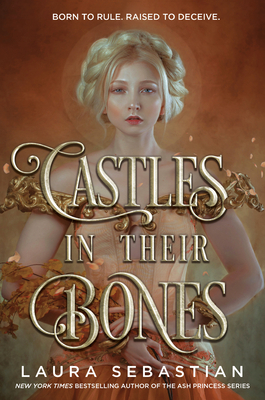
SUMMARY: The plot: overthrow a kingdom. The goal: world domination. The plan: marriage.
Empress Margaraux has had plans for her daughters since the day they were born. Princesses Sophronia, Daphne, and Beatriz will be queens. And now, age sixteen, they each must leave their homeland and marry their princes.
Beautiful, smart, and demure, the triplets appear to be the perfect brides – because Margaraux knows there is one common truth: everyone underestimates a girl. Which is a grave mistake. Sophronia, Daphne, and Beatriz are no innocents. They have been trained since birth in the arts of deception, seduction, and violence with a singular goal – to bring down monarchies – and their marriages are merely the first stage of their mother’s grand vision: to one day reign over the entire continent of Vestria.
The princesses have spent their lives preparing, and now they are ready, each with her own secret skill, and each with a single wish, pulled from the stars. Only, the stars have their own plans – and their mother hasn’t told them all of hers.
Life abroad is a test. Will their loyalties stay true? Or will they learn that they can’t trust anyone – not even each other? (from Hodder)OPINIONS: I hate to utter the word reading slump. But I have been struggling a bit to get excited about the books I’m reading, and I’m once again starting far too many and then just starting a new one next time I pick up a book. And while I do eventually finish them, I never really get immersed. Not so with Castles in Their Bones. Slightly aided by a lazy day due to Booster side effects, I raced through the 500-odd pages of this epic fantasy in a few hours, and I already want more. I especially loved the ending – I think Laura Sebastian made some great choices that not every author would have had the guts to go through with – one that sets up strong character arcs for the next book in the series.
The three princesses, Sophronia, Daphne and Beatriz start out as sort of an entity, but as the story goes on, they really develop into their own characters and the differences between the sisters become clear. They are not damsels, but manipulators, though it soon becomes clear that they may not be in control as much as they believe themselves to be. I did feel like the side characters did not get quite as much attention as the triplets, and, for example, their respective spouses/fiancés were not as well-rounded as the girls themselves. It did sometimes feel like they were interchangeable almost. But ultimately, it didn’t diminish my reading experience.
In terms of plot, the story was compelling, if not fully surprising. I think the best way to describe Castles in Their Bones is as a comfort read – taking on enough of the familiar beats of YA epic fantasy to create an atmosphere of recognition in some ways, while also taking them and twisting them into something of its own. It is reasonably fast paced, which adds to the compulsive readability. For me, this will be a book I’m going to reread, because it’s perfect to curl up with under a blanket and sip on a mug of tea or hot choc. Because I too have castles in my bones.
Add Castles in Their Bones to your Goodreads here, and pre-order a copy via Bookshop here (affiliate link).
-
The Key in the Lock – Beth Underdown
I have been absolutely addicted to mysteries and thrillers recently, so this ARC arrived at the perfect time. Set during the First World War, this has two different mysteries at its core, and predominately focuses on how they impact the affected families – in particular Ivy Boscawen, our main character. In the present, she mourns her son, and tries to figure out how exactly he died, all the while being haunted by the death of a small boy in her past. The Key in the Lock is creepy, captivating and haunting. A perfect winter read, really, even if it’s not a flawless book.
Many thanks to Penguin/Viking for sending me an ARC for review. All opinions are my own as usual.
RELEASE DATE: 13/01/2022
STAR RATING: 4/5 ✶

SYNOPSIS: I still dream, every night, of Polneath on fire. Smoke unravelling from an upper window, and the terrace bathed in a hectic orange light… Now I see that the decision I made at Polneath was the only decision of my life. Everything marred in that one dark minute.
By day, Ivy Boscawen mourns the loss of her son Tim in the Great War. But by night she mourns another boy – one whose death decades ago haunts her still.
For Ivy is sure that there is more to what happened all those years ago: the fire at the Great House, and the terrible events that came after. A truth she must uncover, if she is ever to be free.
But once you open a door to the past, can you ever truly close it again? (from Viking)
OPINIONS: This is in parts a historical novel, a mystery and a ghost story. Ivy is haunted by the ghosts of her son and her past, though it is long left unclear whether these are literal or metaphorical. It is one of those books that I find incredibly hard to review, as I think I feel fonder of it in hindsight than I did while reading, already considering a reread to get back into that spooky and uncanny wintery mood with a mug of hot chocolate. The Key in the Lock is certainly one of those novels where you end up wondering what is truly happening until you get to the very end, and I’d love to go back and see the seeds of those revelations in the text.
Ivy Boscawen isn’t the most sympathetic of main characters. While she suffers, she is also an unreliable narrator in a lot of ways, and a very privileged woman. I was never quite sure if I felt with her for her losses and her challenges in life, or if I was annoyed at her for being so oblivious to everyone else’s issues and the way she treated those close to her. But ultimately, that means that she is a great character. She is well-written and complex, and causes emotional reactions in the reader. And to me, that is more important that many other things about a book.
The Key in the Lock is certainly not a book that left me unaffected on an emotional level. It is compelling, unexpected and atmospheric. I would put this in the category of vibe-books, which I’m coming to appreciate as something that does work very well for me. If you too feel that way, I really recommend you pick this up when it comes out next week, as it’s leaving a lasting impression on me.
Add The Key in the Lock to your Goodreads here, and pre-order a copy via Bookshop here (affiliate link).

